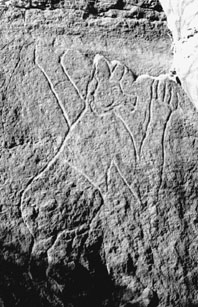

 | Page 46 |  |
albeit on a reduced scale. Even today some researchers are quick to assert derivation or origin, without proof of the reality of transmission, as soon as they perceive an analogy (whether real or simply coincidental) between two sets of flints, two ceramic decorations, or two rock-art themes in two geographically distinct parts of the Sahara.

Jackal–headed man (ca. 4000—2000 b.c.), Mathendous (southwest Libya), about 100 cm. in height
(Alfred Muzzolini)
As for the general archaeology in the Sahara south of the Saharan Atlas, surface collections continued to accumulate due to the lack of excavation. In addition to Acheulean tools, the Aterian stone-tool industry, specific to the whole of northern Africa characterized by Levallois flakes, had also been found in the Sahara. But the blades, bladelets, and microlithic industries constituting the Iberomaurusian (or Oranian) and the Capsian of the Maghreb, industries then poorly defined chronologically as Aurignacian or Mesolithic, were lacking in central and southern Sahara. A well-characterized Neolithic, with geometric microliths and pottery, was found abundantly throughout the Sahara and was transgressive above older layers. However, in 1933 Raymond Vaufrey demonstrated the faulty linkage between the Capsian and the Aurignacian. On the contrary, the Capsian of the Maghreb, always stratigraphically above the Pleistocene layers, was found to continue in the form of microlithic survivals within the flint assemblages of Neolithic layers. This led Vaufrey to create the concept of the Neolithic Capsian tradition (NCT), within which he included the whole Neolithic of the Maghreb, the Sahara, and some extensions into tropical Africa.
From the 1930s on knowledge of Saharan rock art also grew. In 1932 the young T. Monod published his work on the engravings of the Ahnet Massif (Hoggar) and proposed a general pan-Saharan classification of the engravings, based on the diffusionist concepts of the period. Like Obermaier, Monod defined stages by means of styles and techniques (and not by fauna, as is often wrongly written), and he added to each stage, a fossile-directeur (marker fossil). His aim was to imitate the traditional and efficient methods used by geologists and paleontologists to characterize a stage. However, the analogy was deceptive. The fossile-directeur constituted only a sort of a posteriori label, not a discriminating criterion. After some rearrangements the sequence became the classic one, which Henri Lhote adopted and popularized and which is still widely used, in spite of diverse reservations and corrections made later on. The sequence includes: the Bubaline school (only engravings, in naturalistic style and with ancient buffaloes), the Bovidian school (mainly paintings, in naturalistic style and with domestic cattle), the Caballine school (in schematic style and with horses), and the Cameline school (in crude geometric style and with camels). These schools were also considered periods.
Vaufrey’s important publication of this period, L’art rupestre nord-africain (Cave Art of Northern Africa,1939), put an end to the controversy over the age of Saharan art. Vaufrey argued that the rock-art sites were not Paleolithic because (as already mentioned by Flamand) ceramics had been found in almost all of the rock-art
 |  |